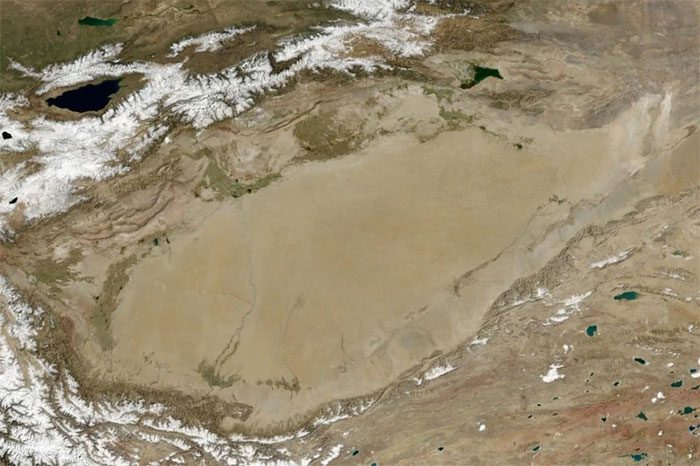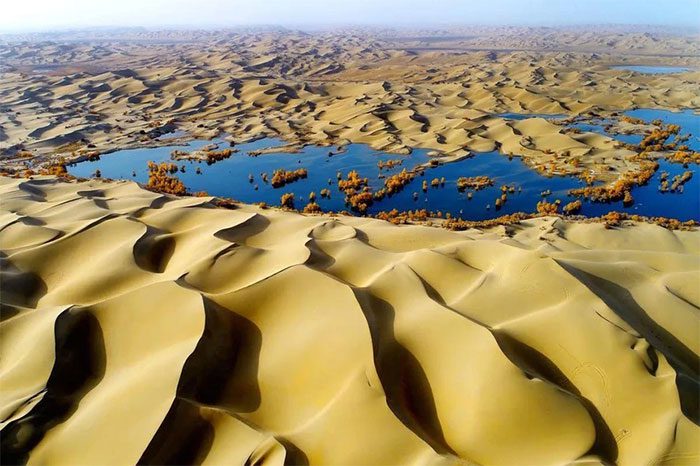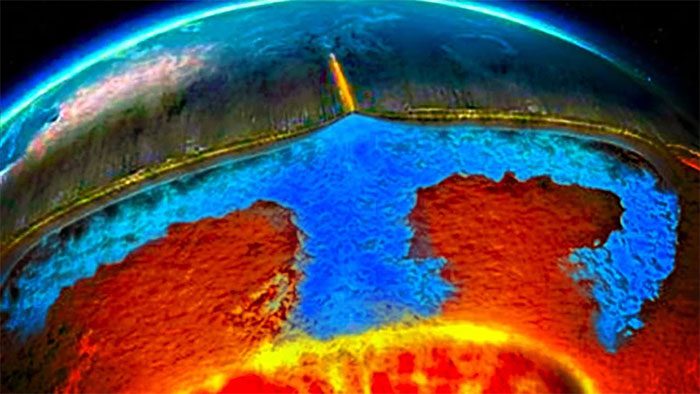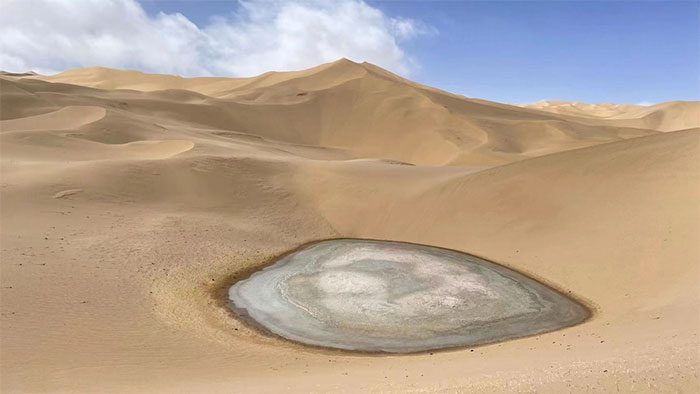In the remote desert region of Xinjiang, China, there once existed a marvel that amazed the entire world—a secret realm known as the “subterranean ocean,” quietly existing and posing a significant challenge to our understanding of the natural world.
Decoding the Formation of the “Subterranean Ocean”
In ancient times, the geological structure and climatic environment of the Earth underwent tremendous changes. About 500 million years ago, there was only one colossal supercontinent named Pangea. However, over time, Pangea began to break apart, forming many smaller landmasses and continents.
During this period, the ocean area was relatively small and in a relatively stable state. However, with further development of plate tectonics, significant changes occurred in the marine geographic environment. These changes triggered the formation of underground oceans.

Chinese scientists discovered a massive amount of groundwater beneath the desert of the Tarim Basin in Northwest Xinjiang, potentially ten times the water volume of the Great Lakes in the United States.
Subsurface oceans are formed through the interaction between plate movements and the dynamics of the crust. When plates collide or rub against each other, the seafloor crust of ancient oceans can be compressed and pushed, causing it to sink deep underground. These buried blocks of seawater gradually form underground oceans.
The uplift and subsidence of the Earth’s crust also lead to the sinking of ancient oceans. For example, when the crust rises, seawater can be lifted deep underground, forming subterranean oceans.

Subsurface oceans are formed through the interaction of crustal movements. (Illustrative image).
These underground oceans typically lie at depths of several thousand or tens of thousands of meters and contain a vast amount of water. Their existence has significant impacts on the water cycle and the geological environment of the Earth. The freshwater and saline water in underground oceans interact, creating chemical reactions that can alter rock and further influence the structure of the Earth’s crust.
Through the advancement of modern science and technology, we can explore and better understand these underground oceans. Earth scientists use seismic wave detection technology and geological probing equipment to study underground oceans. These studies not only help reveal the evolutionary history of the Earth but also aid in understanding the distribution and utilization of water resources.

The salt concentration in the water of the ‘subterranean ocean’ in the Xinjiang desert is quite high. (Illustrative image).
Characteristics of the “Subterranean Ocean” in the Xinjiang Desert: Saltwater Lakes Hidden Underground
One of the defining characteristics of the subterranean ocean is its salinity. The salt concentration in the water of the “subterranean ocean” in the Xinjiang desert is much higher than that of saltwater lakes, nearly double that of seawater. The high salt concentration is due to prolonged evaporation caused by the desert climate, making the water dense and rich in salt.
Some locations of the ocean lie deep underground and require extensive excavation and drilling to access, while in other areas, it is found closer to the surface and can be sustained by natural infiltration and replenishment from surface water sources. Regardless of depth, its existence depends on special geological structures, fault zones, and other geological phenomena.
Due to the surrounding desert environment, water is a precious resource for organisms in this ocean. Although it is highly saline, some microorganisms and plankton adapted to high salinity environments can still survive and thrive within it.
These hidden underground lakes are also valuable resources for scientific research. By studying water and sediment samples from these lakes, scientists can learn about climate and environmental changes throughout Earth’s history. Additionally, there may be unknown biological populations and ecosystems within these oceans, providing unique experimental sites for biological and ecological research.

Professor Li Yan, head of research at the Xinjiang Institute of Ecology and Geography of the Chinese Academy of Sciences in Urumqi, the capital of Xinjiang, told the South China Morning Post: “No one ever dared to imagine that there was so much water beneath the sand.”
The Ecological Environment of the Underground Ocean
The key to the adaptation of marine organisms in the underground environment to harsh conditions lies in their source of energy, which is both photochemical and chemical. Due to the absence of sunlight, marine organisms in the underground ocean cannot rely on photosynthesis to obtain energy from sunlight. Instead, they depend on chemical energy, utilizing hydrogen sulfide, methane, and other chemicals for chemosynthesis. This unique metabolic process, known as chemosynthesis, allows underground marine organisms to survive.
Marine organisms in the underground ocean also need to adapt to high-pressure environments. Since the subterranean ocean is located in deep oceans, it is subjected to immense pressure. Typically, pressure increases by 1 atm for every 10 meters of depth. In underground oceans, pressure can be hundreds of times greater than surface pressure. For most organisms, such pressure would cause ruptures or damage to cellular structures, but underground marine organisms have developed special structures to adapt to high-pressure environments.

Marine organisms in the underground ocean also need to adapt to high-pressure environments. (Illustrative image).
The cell membranes and proteins of these organisms possess properties that resist high pressure. The lipids in their cell membranes have higher density and smaller lipid droplets, thus enhancing the stability and resilience of the membranes. Proteins also have more stable structures to withstand the impacts of high-pressure environments. Additionally, the bodies of underground marine organisms contain substances that help prevent damage to cell membranes and proteins, such as antifreeze proteins and antioxidants.
Besides adapting to high-pressure environments, marine organisms in the underground ocean must also cope with low temperatures. The temperatures of underground oceans are typically below 0 degrees Celsius, significantly lower than surface temperatures. The key to adapting to low-temperature environments lies in the structure and composition of their cell membranes. High levels of unsaturated fatty acids in cell membranes can lower the freezing point of the membrane and keep it in a liquid state. Furthermore, underground marine organisms secrete exopolysaccharides to form protective layers that prevent ice crystals from damaging cell membranes and cellular structures.
The ecological adaptations of marine organisms in the underground ocean are also related to their relatively stable environment. Because underground oceans are unaffected by external light and climate change, the organisms here do not have to deal with the stresses caused by these changing factors. This allows underground marine organisms to thrive in a more stable environment and adapt better to its harsh conditions.




















































